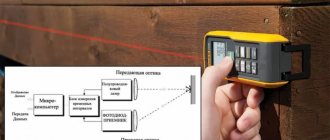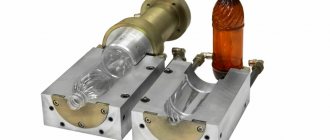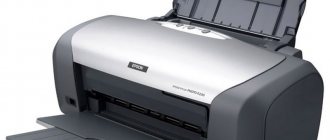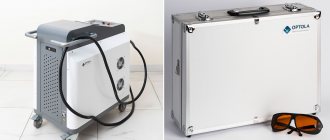Laser CNC machines are used to produce furniture, promotional items and souvenirs from wood or plastic. The engraver's range of actions includes cutting, burning, and engraving. The workflow is quick and easy. Laser can be used to apply pictures, emblems and logos to wooden and plastic surfaces.
An engraving machine can be purchased at a store or assembled with your own hands. Making a laser for cutting plywood yourself is not that difficult. A homemade device will have lower power and, nevertheless, you can create full-fledged engravings on it.
Laser machine control board: M2 Nano, RuiDa
So, well, let's start then! Let's start with the front panel!
This model has a RuiDa control system, not an M2. RuiDa is a cooler board. The main advantages of the RuiDa board:
- Ability to change laser power without human assistance. Thanks to this, you can engrave photographs. On the M2 you can only do single color engraving in one pass.
- Continuation of operation from the moment of emergency stop. For example, if the electricity goes out, after turning it back on, the machine will continue to work as if nothing had happened.
- Ability to work without a computer, reading a file from a flash drive.
- Possibility of connecting the machine to a local network.
- Availability of a Russian interface (for many users this is important).
- Possibility of embedding LaserWork into graphic editors CorelDraw, Adobe Illustrator, Autocad, Inscape.
- Backlash compensation.
- Self-diagnosis.
- Supports multi-positioning (you can set several reference points to start working).
- Ability to view layers
- Calculation of the exact processing time of the material
You can change the board from M2 to RuiDa at any time, you will have to tinker for a day, though.
The top photo shows just the front panel, but the brains of the machine look different. Here they are:
M2 Nano control board
To make it clear: this board consists of:
- USB UART converter - transmits and converts commands received from the computer to the microcontroller
- Microcontroller - converts commands directly into the movement of the laser head itself and turning the laser on/off. He does this with the help of stepper drivers.
- Two stepper motor drivers - control the current of stepper motors.
- Harness
RuiDa control board
RuiDa's structure is much more complex. Here it is disassembled.
There is already a fast 32-bit TMS320 microcontroller, Altera FPGA and memory modules. This is what I saw right away; I didn’t look for the rest on the Internet. The point is clear. The capabilities of this board are much higher - it is an independent computer. However, RuiDa does not have stepper motor drivers on board - they will have to be purchased separately.
Materials for processing
Using laser machines with numerical control, you can process the following materials: acrylic, polyester, two-layer plastic, plywood, veneer, wood, cardboard and paper, leather, stone, glass, mirror, etc.
And with the help of non-contact technology, it is also possible to process fairly thin materials (paper, leather, etc.) - these are materials that until recently were quite difficult to automate.
Stepper motor drivers for laser machines
Don’t rush to buy the most expensive drivers right away. Drivers have three main parameters: current, the minimum period length for the STEP clock signal, and the maximum microstep. If you have questions, it’s better to ask ON THE FORUM
We even made a special expansion board for the small laser machines of the HOBBY and OPTIMA series.
Using this board, we can install more powerful drivers instead of standard drivers, or vice versa, drivers that will make the engines operate absolutely silently. This idea came to my mind after I was assembling another machine and I needed drivers, but everything was out of stock. I bought expensive stepper motors in a St. Petersburg store and installed them on the machine - everything seemed to work, I drove it at high speeds and that was it - skipping steps right away. I thought for a long time what the problem was until I figured out how to figure it out. It turns out that instead of a branded mikruhi, there was some kind of Chinese remake. We had to remove the drivers from our office machine so that the person would not delay the delivery, however, now the person has super powerful 5 Ampere drivers, although in reality they need 0.5 Ampere and 1 Ampere. We sign all the machines, because people get the hang of it much faster this way. The drivers on this machine are installed on the right.
Well, in the meantime I made the following temporary solution for our standard machine:
I took the drivers from our 3D printers and configured Ruida for them, soldered everything together, and until the arrival of new drivers, everything will remain in this state. The main thing is that everything works at high speeds. Engraving at a speed of 500 mm/s without problems.
In general, the task of stepper motor drivers is to provide the correct current to the windings and not slow down when receiving control signals from the microcontroller, so that the motors quickly and accurately ensure the movement of the laser nozzle over the working field.
DIY machine
It is not so difficult to create a CNC laser machine with your own hands; for this you will need to stock up on the appropriate material. The device will differ from industrial machines in power. A homemade laser machine will have a power of about 2 W, while industrial machines use lasers with a power of 50 W. Using such equipment it will be possible to process cardboard, wood, and plywood.
To assemble the engraver yourself, you need to purchase a programmable board. They are presented in a wide range in the store; any mechanism can be assembled on their basis. Homemade machines differ from factory machines, but a machine of this type can be used to carry out a wide range of work. Do not forget that lasers must be cooled; for this purpose, a special cooling system is created using a pump and liquid.
Laser tube ignition unit
You can return to the previous drawing - this block is signed. Quite a massive black box. Another important element of a laser machine. In order for the tube to work, this unit raises the voltage at its terminals to a voltage of more than 20 kV and raises it until a discharge begins in the tube. If the tube fails and the discharge never begins, the high-voltage unit will either turn off or continue to produce the highest possible voltage, which can damage it.
Let's assume that the tube is working properly and the discharge has begun - now the high-voltage unit turns on the current stabilizer to maintain the required current, regardless of the load in the circuit. The voltage usually decreases.
Which machine to choose: studying the varieties
Laser machines are divided into types according to several principles.
According to functional load:
- A laser engraving machine produces a weak beam of light, which is enough for engraving and burning. By increasing the wavelength, the machine can cut plywood sheets.
- A laser-milling machine for cutting plywood with increased light beam power can cut wood and create grooves on products. Often you can use it to engrave by simply setting the laser to this function.
By type of control:
- A manual woodworking machine is the cheapest and easiest to use. With its help, they create unique products of their kind.
- CNC significantly increases the cost of equipment, but also improves the quality of manufacturing absolutely accurate designs and shapes. Just set the program and the machine will do everything itself. In most cases, such installations include both control methods.
By power and size:
- The laser engraving desktop device with a low power of up to 80 W is compact and can be placed in a small workshop or at home. The installation is suitable for creating small souvenir products; the machine can engrave and cut thin plywood.
- A professional laser engraving and cutting machine produces a power of 80-195 W. It has increased dimensions and is used in the woodworking and furniture industries for the production of serial products and cutting out precision parts. The cost of such a device starts from 150 thousand rubles.
- An industrial wood laser cutting machine can cut, sharpen, engrave and much more. It has impressive dimensions and is used in large woodworking workshops.
Manufacturers equip the equipment with various functions that affect the cost of installation and replace the use of additional tools that facilitate the processing process:
- Chiller is a device for cooling the laser tube. It is necessary during prolonged operation of the machine to normalize the temperature of the working parts of the equipment. It works on the principle of a secondary casing with circulating water connected to a pump. If the machine is not equipped with such a device, it must be purchased separately. Cost from 30 thousand rubles.
- A blowing system for the cutter and engraver is needed to reduce the temperature of the cutting and burning area in order to avoid excessive charring of the seam. In addition, dust and debris are constantly blown away from the workplace, which improves work comfort and production quality.
The choice of a laser machine is determined by the needs for its power and functionality. For large-scale production, it is not advisable to purchase a small desktop unit, just as it is not advisable to install a professional or industrial unit for your home.
There are universal installations that can work with metal, wood, PVC and perform various operations: engraving, cutting, milling. The cost of such installations is high and it is advisable to purchase them only for large-scale production.
We present a table with three popular models of machines of different configurations and power:
| Type | Dimensions, mm | Functions, beam power, W | price, rub. |
| Desktop engraver SF40B | 350x 500x 800 | Engraving, 40W | 93 000 |
| Laser machine LT-460 | 1070x 750x 670 | Engraving, cutting wood, glass, leather, cardboard, 50 W | 150 000 |
| Laser engraving machine AL-1412 | 1960x 1610x 1120 | Cutting and engraving of wood, coated metal and other materials, 60-150 W | 420 000 |
As you can see, increasing the laser power for a machine affects the cost of the equipment and its functionality. Manufacturers offer modifications of similar units with different sets of functions; the price and quality of products may differ significantly from those presented.
Manufacturers and service
Engraving machines for laser cutting of wood and processing products are offered by manufacturers from different countries: Russia, Japan, and European countries. It cannot be said that they differ significantly from each other, but the representatives have their own characteristics.
A prominent representative of Russian developers is the NPF “Lazers and Equipment”, Zelenograd. The company produces machines of different functionality, the products are relatively affordable.
Japanese brands Koike and Mazak produce equipment that is easy to operate both manually and automatically.
European brands Trumpf, ESAB, Bystronic provide the most diverse functional equipment with a long service life. The units are designed for processing wood, metals, acrylic and other materials, both specialized and universal.
Reliable manufacturers provide a guarantee on their products. High-quality devices serve without interruption for years; adjustment of the laser device is rarely done if necessary.
Laser tube
Oh, this is the most interesting place. For many, something strange and incomprehensible begins here. Let's start simple: what is a laser tube?
Let's start with the simplest definition. The laser tube is a glass bulb that has 3 internal cavities. Water or other coolant flows through the middle of the cavities. But in the other two cavities there is a mixture of gases. What kind of mixture of gases is this?
It consists of:
- CO2 (carbon dioxide) is a gas that releases energy in the form of photons. Together they produce laser radiation.
- N2 (Nitrogen) is a good resonator. It converts most of the absorbed energy into vibrations, causing CO2 particles to collide with each other.
- He (Helium) - it increases the rate of photon emission. But Helium also has high thermal conductivity, which helps keep CO2 at a low temperature. And the low temperature of CO2 allows you to create a high population of low energy levels. This allows CO2 to emit more new photons. Well, the low temperature of CO2 slows down the rate of its degradation. But Helium atoms are very small and they even leak through the glass from which the laser tube is made. Therefore, an old tube (more than 2 years old), which has never even been used, will have a low radiation power, and will also very quickly become unusable due to CO2 degradation.
A photon is emitted in the following cases:
- A charged CO2 particle collides with a photon or neutral atom.
- Collision of N2 atoms with CO2 atoms
- Exposure to external electromagnetic field
In order to create positive feedback, the tube has an optical resonator.
Laser tube structure
The resonator consists of a glass bulb (marked in red) and two mirrors. One has a reflectance of 100% (in practice 98%), the other has 50%.
Interference of waves occurs in an optical resonator. The wave traveling near the resonator axis is amplified and reflected from the mirrors. Moreover, with each such reflection, the wave only partially passes through the mirror with a reflection coefficient of 50%. Actually, the first 50% is supplied directly for cutting the material, and the second half is reflected and remains in the resonator.
The higher the temperature of the laser tube, the paler the violet discharge becomes.
Lenses, mirrors, optical accessories
Alfa-J laser engravers use the latest generation of mirror holders, a protective casing protects from dust and combustion products, and makes it easy to find the center of the mirror when adjusting:
We have never seen such an implementation on any competitive machine. Also pay attention to the system for adjusting the position of the mirrors; there is an adjustment for both the offset at the base of the holder and three-point adjustment of the mirror tilt with locking locknuts; such a system will allow you to accurately adjust and securely fix the adjustment position for the entire period of operation.
You can choose from solid molybdenum mirrors; such mirrors can be polished on a tool maker’s polishing table if they become cloudy; you can also install silicon ones with copper plating - such mirrors cannot be polished, but are also cheaper.
The diameter of mirrors and lenses is important when specializing a machine for engraving or cutting. Thus, large-diameter mirrors and lenses reflect and transmit a laser beam with minimal power losses, which is good for cutting, but in engraving, the characteristic of the size of the light spot becomes more important, and the smaller the diameter of the laser beam at the entrance to the lens, the more compact the light spot will be. material. And since any beam, even a laser one, has the property of scattering as the beam of a flashlight becomes wider as it moves away, for engraving it is better to use optics with smaller diameters in order to minimize the diameter of the beam when transporting from the emitter to the lens in the head, therefore engravers use mirrors with a diameter of no more 20mm, and lenses with a diameter of no more than 15mm.
The lens material is also responsible for the compactness of the light spot on the material, so gallium arsenide (GaAs) has a higher refractive index and is more preferable for engraving, and zinc selenide (ZnSe) lenses have a lower refractive index and are preferable for cutting.
For comparison, a photo of bad fittings, fastening on a thin bending corner, fixing with a lock nut - throws off the set settings, savings even on the spring clamp - made from a hairpin:
Laser machine mirror system
I hope you now have a better understanding of how the laser tube works. Let's return to the half of the radiation that is released by a mirror with 50% reflection. This radiation will cut the material. But first you need to direct it correctly. The quality of the cut greatly depends on the correct setting of the mirrors.
As soon as the radiation leaves the tube, it hits the surface of the mirror for the X axis. This mirror is motionless, the adjustment must begin with it. The main task is to make sure that the beam reflected from this mirror hits the same point on the mirror along the Y axis. It doesn’t have to hit the center, the main thing is that it hits the same point.
After the X-axis mirror is adjusted, you need to adjust the Y-axis mirror in exactly the same way. The last mirror is the lens mirror. Its task is to correctly apply the beam to the lens, so that the lens will correctly and accurately focus the radiation, and you will get a high-quality cut.
Some people who bought a machine somewhere else have a problem. Even if all the mirrors are clearly adjusted, the beam does not hit the same point in different places. The answer to this problem is almost clear - the fault lies in the mechanics and the machine guides are not parallel.
Air pump
The air pump serves to remove combustion products from the optics in the laser head, as well as to remove combustion products from the cutting area. To suit the customer's needs, it is possible to equip up to an air pump for a laser engraver 385 W 300L/min. Such a powerful pump may be required to cut paper and cardboard without burning, or to cut wood with minimal carbon deposits.
Lens focusing, table lifting mechanism
Adjusting the lens focus can be done in three ways:
- Manual focusing: installed on the most budget models, you adjust the height of the lens yourself. An absolutely normal manual method, due to the absence of additional mechanical parts, such machines are very small.
- Focusing using a lift table. Here the table is already connected to screw rods, which are driven by a motor.
Screw rods, motor and honeycomb table
- Focusing using lift table + autofocus. The same as the second one, but there is a limit switch or distance sensor near the nozzle. Thanks to this device, you simply place a sheet of material on the table, and the machine itself will adjust the focus. True, there are also funny cases. Sometimes limit switches are installed in the form of a thin button. People can also be inattentive and tired. And if the nozzle is not above the sheet material and you turn on autofocus, then there is a very high probability that the button will fall between the table honeycombs or slats, the machine will not notice the obstacle and will continue to raise the table. I won’t show you how it all ends here). Conclusion: make sure the end cap is thick enough, be more careful or focus manually, it takes no more than a minute.
- Add. option - RED LIGHT focusing. To be honest, I never use it, maybe in vain, but somehow it’s easier for me to make a measuring figure and focus on it.
Frame
The housing affects the dimensions of the material being processed, the correct cutting and engraving geometry, maintaining the geometry during transportation and operation, affects the protection of key components, such as control electronics from material combustion products, the ability to install options such as a lifting table or conveyor, the ability to feed long materials through work table top.
When choosing manufacturers for the range of laser engravers, we took into account all the necessary wishes in the lines of manufacturers Alfa-J and JQ, the latter has more than 10 years of operating experience in the Russian Federation, including in harsh conditions of stone engraving, and Alfa-J has similar characteristics without overpaying for brand.
For example, all the edges of the steel sheets when assembling the body have an end bend, which adds lateral rigidity compared to competitors:
The control panel is enclosed in a separate casing to protect it from combustion products:
Hinged housing covers allow processing of long materials:
Thus, the body of Alfa-J machines is suitable for specialization for any task, has a large margin of safety, thoughtful details, such as pneumatic struts for lids, limit sensors for closing lids, and on their basis you can build any cutting or engraving machine.
Laser tube cooling
Here I would make a division into three types:
- The CW3000 chiller is a rather useless option. The essence of his work is as follows. The CW3000 is a tank of approximately 9 liters with a radiator, pump and fan. All. As you understand, the tube quickly warms up 9 liters and the radiator and fan cannot cope with cooling, since the machines are installed in heated rooms.
- Pump - despite the fact that this option is cheaper, it turns out to be more effective. The main thing is to use a large container - from 35 liters. With such a capacity, the tube does not have time to heat the water. The main thing is that the room is not too hot. As a rule, in most industrial Temperatures in rooms and houses around 22 degrees are within normal limits.
But sometimes people buy a machine for their home, but there is only a place next to the battery. This is a very bad option, but in this case you can freeze bottles of salt water in the freezer and put them in a container while cutting. - Chillers CW5000, CW5200 are not a cheap option; such chillers are simply necessary for powerful pipes. Their advantage is that even in hot weather you can work on the machine without any fears about the pipe, since such chillers work on the principle of a refrigerator.
Controller
Ruida stands out as the leader among controllers; this manufacturer abandoned the USB key for activation and developed convenient software. The controller model RDC6442G is for machines with one emitter, RDC6442S is for models with two emitters. Leetro with their MPC controllers have lost their relevance today, as have the AWC and Topwisdom controllers.
We would like to separately mention single-board controllers without graphical control panels such as Laser Cube, MKS DLC, Moshi, Lihuiyu, Arduino, etc. — these are still not controllers for serial industrial equipment, because they are very limited in functionality and with very simple software, perhaps suitable for enthusiasts to develop their own machines, but we would not recommend purchasing machines for production on these controllers, no matter how tempting the price.
Main functions
The table of modern laser equipment is usually end-to-end. On such tables you can process workpieces of various lengths. Modern machine designs can be supplemented with various elements to increase functionality.
It can be:
- lifting table, thanks to which you can increase the height along the Z axis;
- rotating mechanisms that are used for processing cylindrical products;
- honeycomb surfaces designed for working with small workpieces.
The laser engraving machine can be automated thanks to the use of CNC. Such mechanisms will be expensive, but they will be more productive and convenient to use.
Using CNC machines, errors in engraving or cutting can be minimized. We can say that they are simply impossible to allow, since control occurs thanks to special software specially developed for such equipment. Difficulties can arise only due to errors made during the development of sketches.
There is no need to perform any manual work on such equipment. The operator’s main task is to monitor the smooth operation of the equipment and monitor the quality of the workpieces produced. Such machines are usually equipped with remote control.











